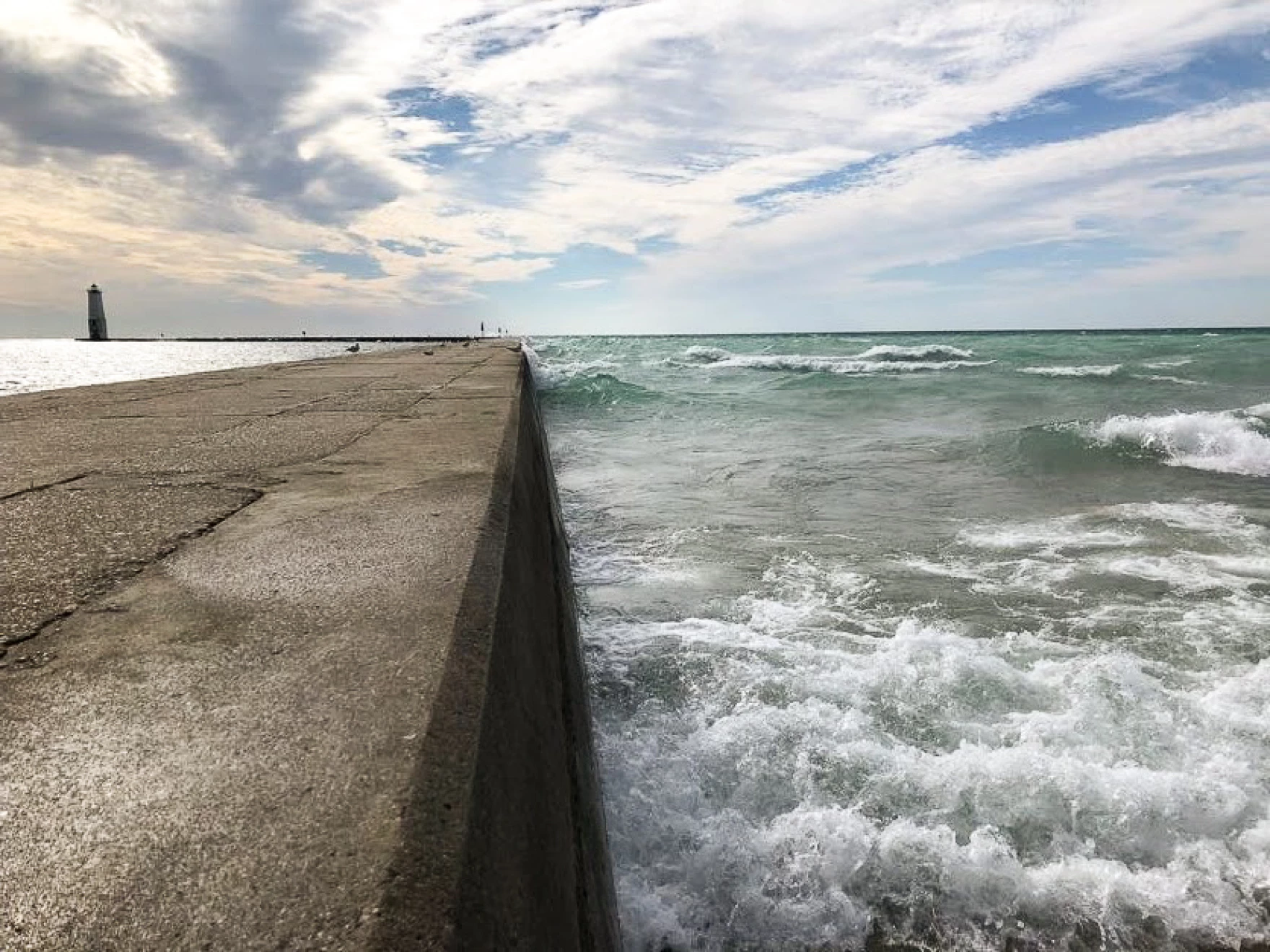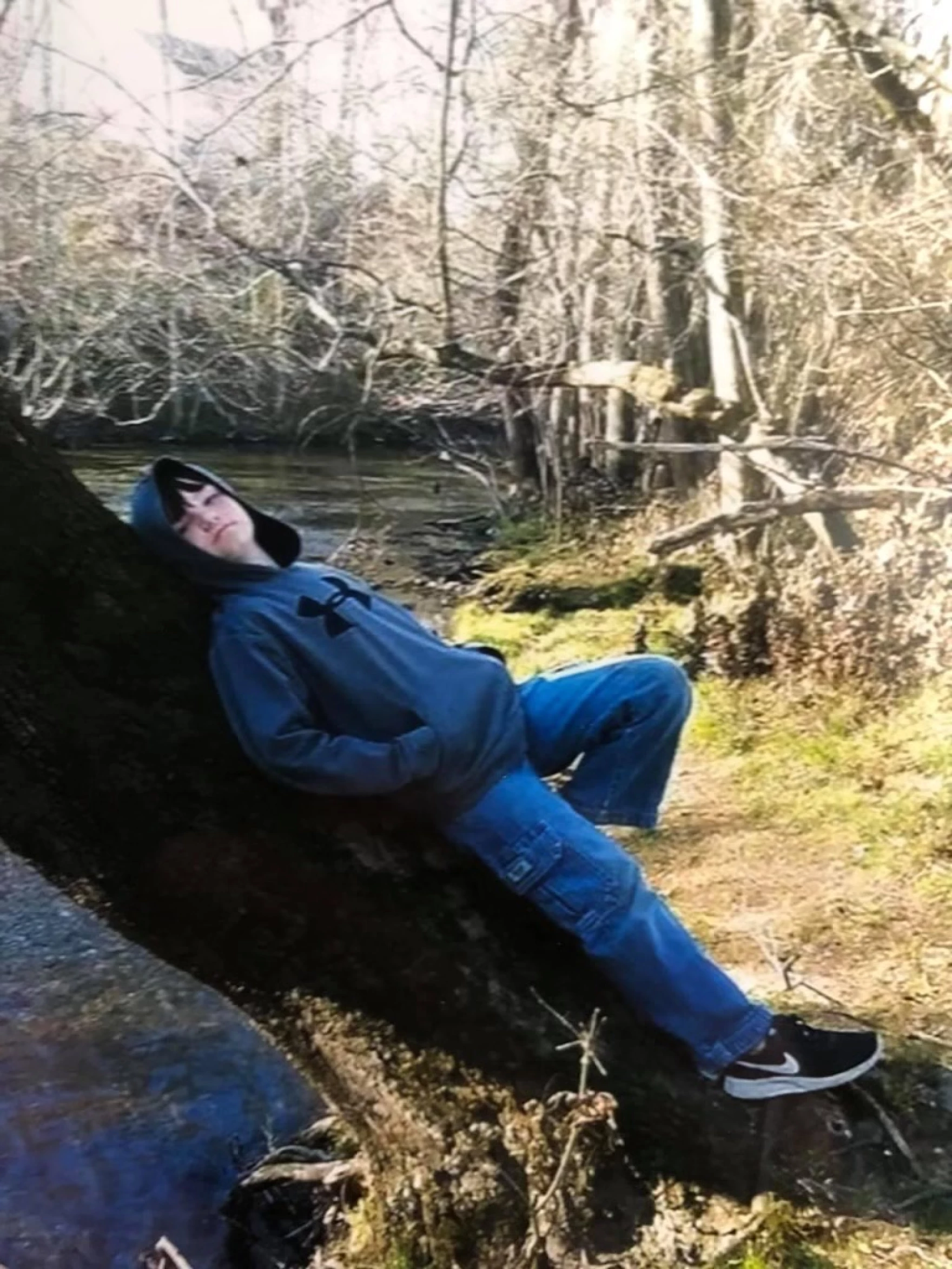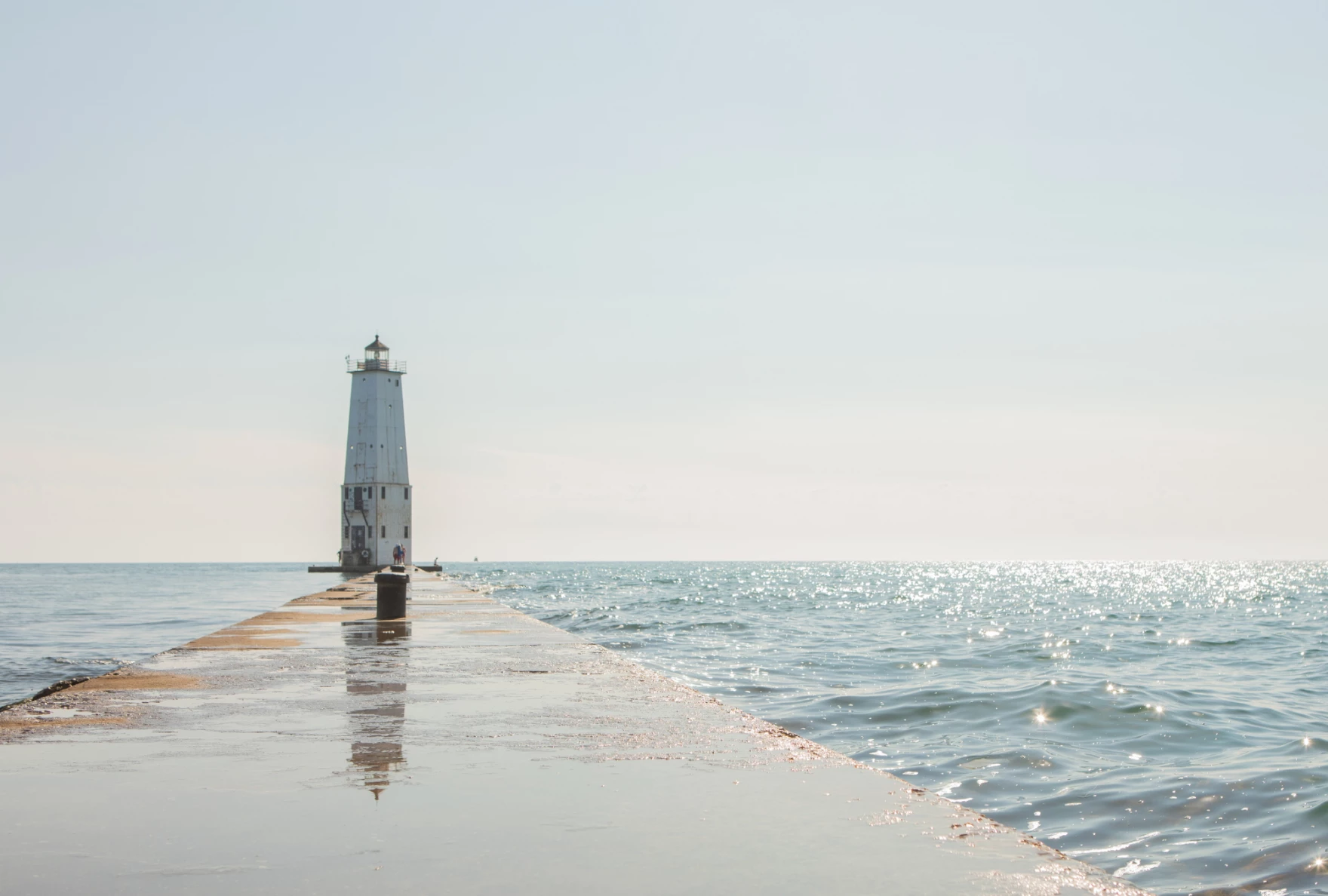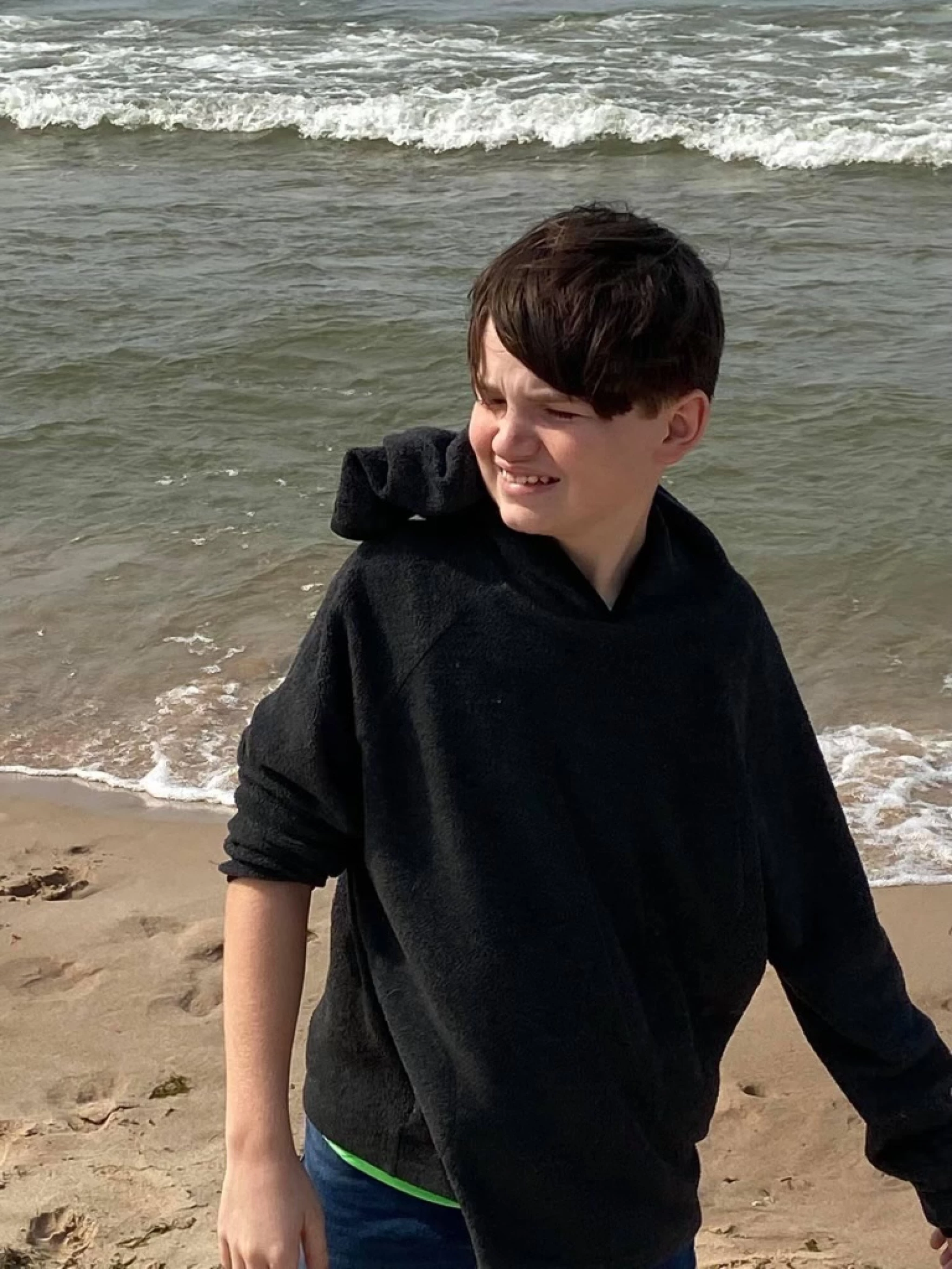
Points North is a biweekly podcast hosted by Daniel Wanschura and Morgan Springer about the land, water and inhabitants of the Upper Great Lakes.
This episode was shared here with permission from Interlochen Public Radio.
On September 21, 2020, twelve-year-old Lane Frame and his brothers were seeing the Great Lakes for the first time. It was a windy day and the water was rough, but they were dead set on walking out on the pier to visit the lighthouse at the end. Then a wave crashed over the edge of the pier, washing two of the boys into the lake.
“And we heard some (of the) awfulest screams you ever heard in your life,” said Jewell Frame II, the boys’ uncle.
One of the boys was able to get to safety, but Lane was not. His heavy clothing quickly became waterlogged, and he sank. Two days later, authorities pulled his body from the lake.
There are piers all over the Great Lakes. Since 2010, over 1,200 people have drowned in the Great Lakes, and a significant number of those drownings were people swept off piers. Does it have to be that way? Or should cities and towns be doing more to keep people off piers on dangerous days?
CREDITS:
Producer / Host: Dan Wanschura
Editor: Morgan Springer
Additional Editing: Ellie Katz, Michael Livingston
Music: Castor Wheel Pivot, Uncertain Ground, Lakeside Path, Our Names Engraved, Warm Fingers, Dolly and Pad, Sals Piano Solo, and So We Go by Blue Dot Sessions.

Lane Frame (courtesy: Joy Frame)
TRANSCRIPT:
DAN WANSCHURA, BYLINE: Lane Frame was 12 years old when he saw the Great Lakes for the first time.
WANSCHURA: Do you remember his reaction once he saw Lake Michigan?
JOY FRAME: Very excited.
WANSCHURA: That’s Joy Frame – Lane’s aunt.
JOY FRAME: He jumped out of the car and they were screaming and running toward the– and I was running behind them with my camera taking pictures cause I wanted to see their excitement.
WANSCHURA: It was September 21, 2020. Lane was in Michigan on a family vacation. They drove up from Tennessee, and stopped in Frankfort – a small, Lake Michigan beach community.
Jewell Frame II – Lane’s uncle, and Joy’s husband – thought the lake was the ocean.
JEWELL FRAME II: Our lakes around here is like, I mean, you can swim across them if you’re a good swimmer. I mean, they ain’t got no waves and stuff like that. That up there, Lake Michigan, it breaks, it breaks waves like an ocean and it’s amazing, really.
(sounds of waves crashing against the Frankfort pier)
WANSCHURA: The late September day was a little windy, but the sun was out, the skies were blue, and temps were in the 60’s. The water was wavy, and a bit chilly for a swim, but there were a few people parasailing. From the parking lot, Lane, and his siblings cut across the beach and ran towards the pier.
JEWELL FRAME II: So, we wanted them to have fun, and that was really why we ended up on that pier.
WANSCHURA: In some ways, this pier defines Frankfort. It’s a giant concrete walkway that extends out in Lake Michigan. At the end of it, there’s this beautiful white lighthouse. Every year, locals and tourists flock to it by the thousands.
And so did the Frame family.

Every year, thousands of people visit the Frankfort pier and lighthouse. (credit: Meagan Wanschura / Points North)
12 year-old Lane, was out in front with his three younger brothers. Shonda Frame-Reedy, another aunt, was also with them. Coming up behind them was Jewell and his wife Joy, who were starting to feel uneasy about going any further.
JEWELL FRAME II: The water was starting to break up high over the pier and it was getting slick. And I hollered at my sister Shonda to come back and she wouldn’t listen to us.
WANSCHURA: That’s because they were on a mission. The boys and their aunt wanted to take a picture by the lighthouse, so they pressed on. That’s when Jewell called his sister.
JEWELL FRAME II: She answered the phone and I said, “Shonda, it’s getting too dangerous. Y’all just come on back.” She said, “Oh, I got it. I can swim.” I said, “Just come back and let’s talk about it anyways.” She said, “I’m just going to carry them on to the lighthouse and we’ll be right back.” And I said, “Shonda, you better be careful.” She said, “I can swim, it’s okay.”
WANSCHURA: The boys knew how to swim, too.
Just moments later, a big wave hit the edge of the pier, and crashed into Shonda and the four young boys.
JEWELL FRAME II: And we heard some (of the) awfulest screams you ever heard in your life. I mean man, it was terrible.
JOY FRAME: And I looked and it was like a fog over it, even though it was a pretty day. I guess it was the mist of the water, but it was like a fog. And I said, Jewel, I don’t see the kids. I don’t see Shonda. And I knew in my heart though that it was bad, that something was wrong.
WANSCHURA: This is Points North. A podcast about the land, water, and inhabitants of the Great Lakes. I’m Dan Wanschura.
Unfortunately, it’s not uncommon for people to get washed off piers into the Great Lakes.
There are 135 federal harbors – most of them have a breakwater, or what’s commonly called a pier or jetty. And lots of people go out on these structures when they shouldn’t.
So, can something be done about it? That’s coming up, right after this.
(sponsor message)
WANSCHURA: They’d been swept off the Frankfort pier and into Lake Michigan – Shonda Frame-Reedy, and two of her nephews, Cody and Lane. The other two boys clung to a big post and stayed out of the water..
In the lake, Shonda was able to reach Cody and push him towards the pier. He grabbed onto a giant chain, and pulled himself out.
JEWELL FRAME II: Next thing I know, I could see Cody running towards us screaming, and I said, “Oh, God, something’s wrong.” He said “Lane and Shonda’s in the water, they’re in the water.”
WANSCHURA: Jewell Frame II took off running up the pier. On the way, he grabbed a life preserver hanging from a pole. When he finally saw his sister, Shonda, she was floating on her back, about six inches under the water.
JEWELL FRAME II: And I threw that life preserver at her and told her, I said, “Grab the life preserver, grab the life preserver!” But she was laying there lifeless herself.
WANSCHURA: Jewell quickly reeled it back and threw it a second time. But again, not close enough.
JEWELL FRAME II: I said, I’m gonna have to go in after her, she ain’t responded, and, it just happened, thank God, I threw it about the third time, and I hooked her hand.
And when I hooked her hand, I said, “Hold on to it, hold on to it!” And she barely gripped the life preserver. And I started pulling her in. Joy started helping me, and she started slipping. I said, “Slow down, don’t, don’t pull it hard.” I said, “She’ll let go of it!” And we eased her in.
WANSCHURA: By that time, one of the parasailers noticed what was happening. So, he came over and helped Jewell lift Shonda onto the pier and started mouth to mouth resuscitation.
But Lane was nowhere in sight.
JEWELL FRAME II: I run back and forth up and down the pier trying to look for Lane and I couldn’t never, I never (did) see Lane.
WANSCHURA: Rescue boats came; so did a U.S. Coast Guard helicopter. But after almost 10 hours of looking for Lane, the search had to be called off because the lake was just too rough.
The following day, the lake was still too rough. Again, crews were unable to go out and look for Lane. Here’s his aunt Joy again.
JOY FRAME: It didn’t feel real. I mean, when you slept and woke up, it was like, “Oh my gosh, this is real. This is the real deal here.” And then you go to sleep wondering if he’s out there, if he’s cold, if he’s hung up under the pier and maybe got a little breathing hole. You know, you want to think he’s still alive.

Lane Frame pictured shortly before being swept off the Frankfort Pier on September 21, 2020. (courtesy: Joy Frame)
WANSCHURA: Lane Frame was not alive, though. The day of his accident, he was wearing a big, oversized hoodie. Once it got wet, he really didn’t have a chance.
According to the Frame family, the coroner said once Lane went under, he never came back up for air. His body was pulled from the water two days after he was swept off the pier.
JEWELL FRAME II: It was awful. And it took a toll on me and my family and everybody. It took a toll on everybody.
WANSCHURA: Every year, dozens of people drown in the Great Lakes. Pinpointing the exact number is nearly impossible, but according to a Great Lakes water safety group – there have been over 12-hundred Great Lakes drownings since 2010. And people getting swept off a pier contributes to those numbers.
For the Frame family, what was supposed to be a dream vacation, turned into a nightmare. Jewell says Lane and the other boys had never been on a vacation before. Their mom left them when they were babies and their dad was in and out of jail. They spent most of their time at their grandma’s house, but it was an entire family effort raising them.
JEWELL FRAME II: You know, we was just trying to give them something that they can remember, you know. Something that we had a part in.
WANSCHURA: Deep down, Jewell knew the pier was dangerous that day. That’s why he called his sister, Shonda. But he still wishes it had just been closed off.
JEWELL FRAME II: They really should have a cable or a chain across there as you’re entering. Especially when it starts to get into the rougher part of it, they need to have something warning, “Do not pass this point without supervision, without anybody.” Something just to at least slow them down and make them think before they walk along there.

During rough lake conditions, Ludington officials can restrict access to the pier by closing a gate. (credit: Dan Wanschura / Points North)
(sounds of waves crashing against the Ludington pier)
WANSCHURA: There’s something that does just that on the pier in Ludington, Michigan. It’s a gate – about four feet tall.
JOE STICKNEY: I believe this is our fourth season that we’ve had the gate out.
WANSCHURA: Joe Stickney is the superintendent of public works in Ludington. And much like Frankfort, this pier is extremely popular. But the gate can restrict access to it. When it’s closed, a sign indicates that people who go past it, could get fined.
STICKNEY: It all started, uh, back when Lake Michigan was real high and we were having problems with waves coming over the breakwall. We had several people get washed off the pier, and we did have some people drowned in the area.
WANSCHURA: Have you seen people skirt around the gate?
STICKNEY: Oh yeah. Yeah, it happens. And like I said, we’re not physically going to block people completely off. It would be almost impossible to do. So, it’s more of a suggestion or a reference just to say, “We know that we have high seas today, the water’s bad, it’s crashing over. Please don’t go out there. If you do, there may be consequences.”
WANSCHURA: So why didn’t Frankfort have a gate? Well, the community has had a couple of them in the past. But fall storms and winter ice are pretty hard on gates, and at some point the decision was made not to replace them.
JOSHUA MILLS: What we determined through the years was the gate wasn’t going to stop anybody from going out there.
WANSCHURA: That’s Joshua Mills, City Superintendent of Frankfort. He grew up here, and he says gates don’t stop the people who have their minds made up.
MILLS: As a kid, I did it, you know. I went around it. And I saw people go around it.
WANSCHURA: After Lane’s death, Frankfort did install a warning light system that’s connected directly to National Oceanic and Atmospheric Administration data. A green light means it’s safe to swim and go on the pier, while a yellow light indicates caution. A red light means stay off the pier and out of the water.
MILLS: It’s amazing though, when you know, we’re in full force, you know, full red light, pier light. It’s evident that there’s waves crashing, people still want to try to get close to it.
WANSCHURA: The Frankfort pier is owned by the U.S. Army Corps of Engineers. Lots of piers on the Great Lakes are.
CHRIS SCHROPP: They are an attraction for the public, for sightseers, and fishermen and just, you know, recreational use. Although they are not intended for that, they are used for that.
WANSCHURA: Chris Schropp is with the Army Corps. He says these piers were built for navigational purposes only.Basically, to give safe passage for commercial and recreational ships and boats.
SCHROPP: The Corps of Engineers is not a safety enforcement agency, so we can’t prevent people from going out.
WANSCHURA: But after Lane Frame died, the Detroit District of the Army Corps put up signs on all its piers – warning people about the danger of walking on them.
And after a drowning accident in 2000, the Corps helped get life rings on the Frankfort pier. One of those life rings likely saved Shonda Frame-Reedy’s life 20 years later.
But gates – they’re a little more complicated.
In Wisconsin, you can’t block pier access because of the state’s Public Trust Doctrine. It protects residents’ ability to recreate, including fishing from those piers.
Another barrier for gates: liability concerns. Here’s Chris Schropp from the Army Corps again.
SCHROPP: If you have a gate that’s meant to be closed during adverse weather, and for some reason, it was not closed and someone goes out, they kind of open themselves up to maybe a lawsuit. So, I think a lot of times people kind of shy away from that.
WANSCHURA: But more recently, there are a handful of communities – mostly in Michigan – which think gates are worth the risk. And Schropp says that’s been a bit of a 180.
Frankfort is open to bringing gates back eventually. That’s what city superintendent Joshua Mills says.
MILLS: I do feel that if we put something maybe midway out it would certainly benefit those folks that just feel that temptation – that can’t overcome the temptation, so to speak.
Whatever the safety features are, Mills says in the end, it does all come down to a certain level of personal responsibility.
MILLS: I think government has to play a very significant role in warning the public and providing guidance to the public. But there is a certain amount of personal responsibility that has to come into play with this because, like everything in life, there is a risk to a certain degree. You know, I think we try to create an environment that minimizes that, but at the end of the day, we – crossing the crosswalk – you’re expecting that that car is going to stop. You have signage, you have paint markings that clearly indicate that’s a crosswalk. That doesn’t mean that cars stop.
WANSCHURA: Right after Lane Frame died, his uncle, Jewell, spiraled out of control. He was mad at God.
JEWELL FRAME II: Matter of fact, I got two DUIs over it. I never drank in my life and I was trying to find some way out.
WANSCHURA: It didn’t help that Lane’s dad, who was in jail – pinned the accident on him.
JEWELL FRAME II: He kind of blamed me a little bit and blamed Shonda a little bit, and I guess he was bitter a little bit. But I mean, he never been in their life that much. And he wasn’t able to be there then. He can’t blame nobody when they’re trying to do something for them that their daddy should have been the one doing it for them.
WANSCHURA: But now, about three years later, Jewell is more at peace with what happened to Lane. And he doesn’t blame anyone.
JEWELL FRAME II: It’s the Lord’s will, whatever happens, good or bad. So, I believe it was just Lane’s time, and ain’t none of us got an expiration date on the bottom of our foot telling us when it’s time. And it took me a long time to realize that it’s just meant to be.

A sign remembering Caleb Sutter is posted near the pier in Frankfort, Michigan. (credit: Dan Wanschura / Points North)
(sounds of waves crashing against the Frankfort pier)
WANSCHURA: In Frankfort, before you reach the pier there’s a sign remembering another boy who was swept into the lake and drowned. His name was Caleb Sutter, and he died 23 years ago.
The sign is an emotional barrier of sorts, just like this story is – a reminder that these sorts of tragedies keep happening.
Catch more news at Great Lakes Now:
Points North: We Got Jellyfish!
Points North: Dirty Laundry, Invasive Species, and the Limitations of Knowledge
Featured image: The Frankfort Pier pictured on September 21, 2022 – exactly two years after Lane Frame was swept off it and into Lake Michigan. (credit: Dan Wanschura / Points North)




